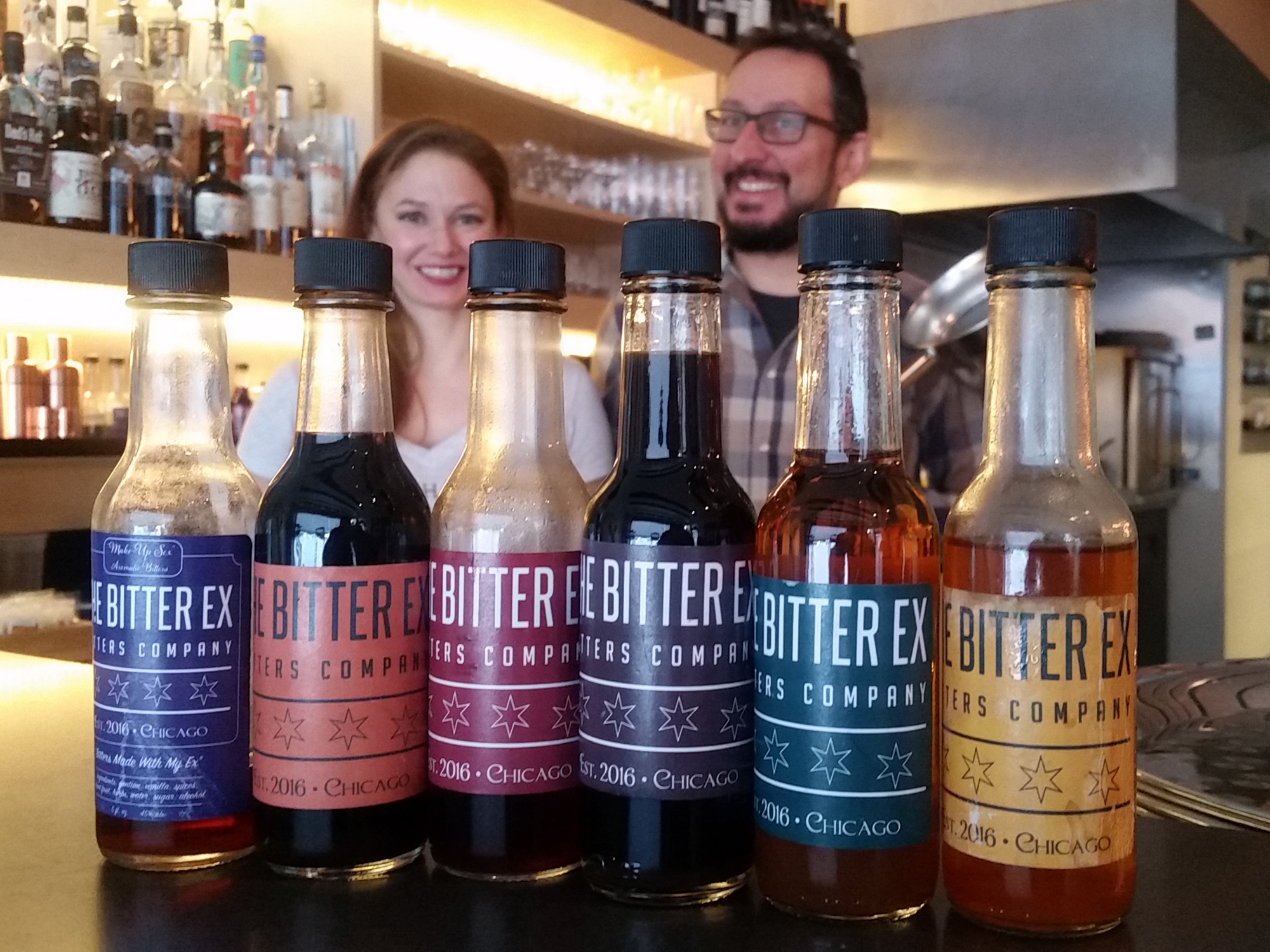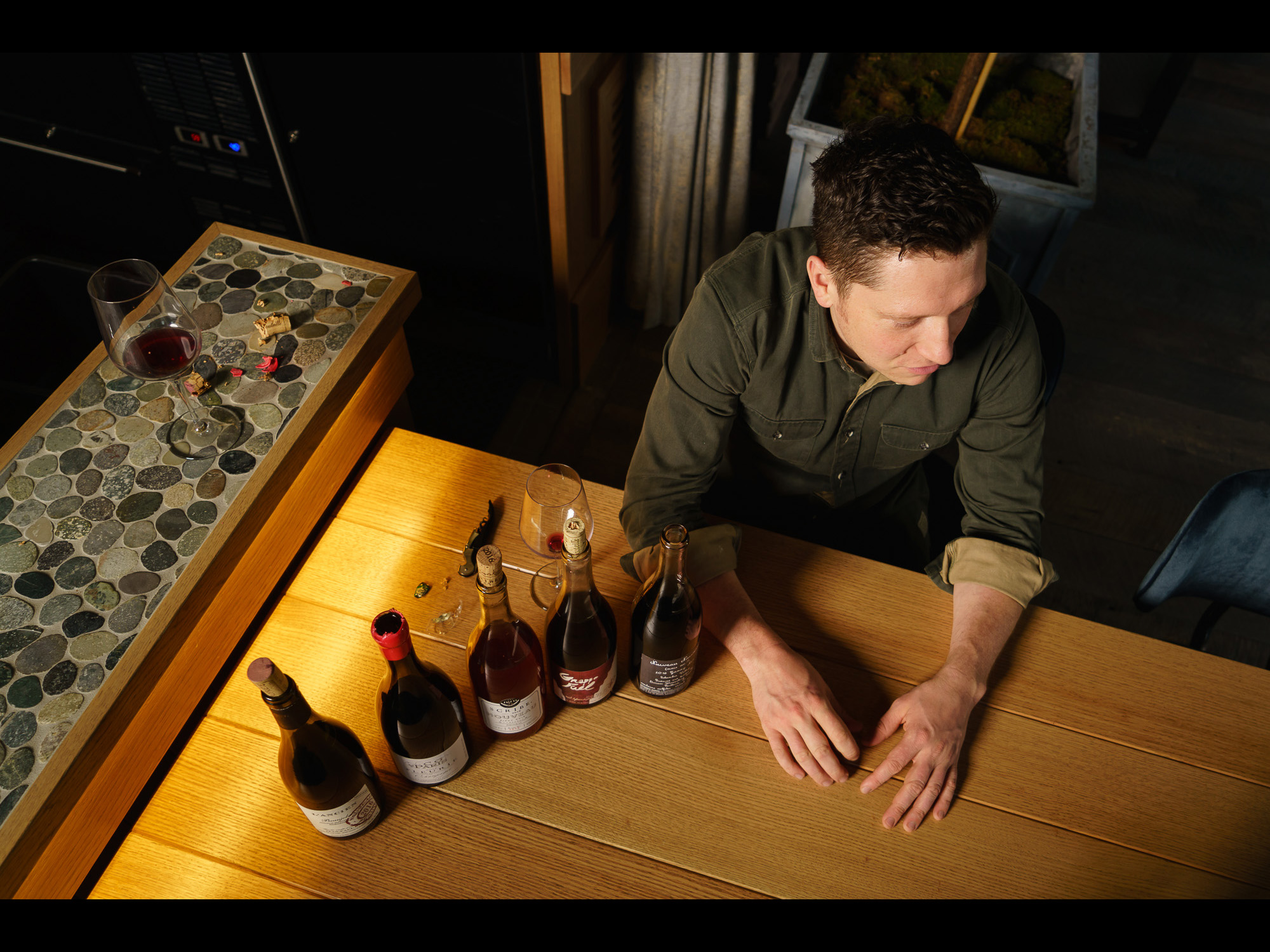A BREWER AND A SALES REP FROM CHICAGO’S Haymarket Brewery are standing at a high-top table in the back of Links Tap Room in Wicker Park. They have four or five hand-labeled growlers in front of them, and the brewer, Trevor Hagen, pours a taste for Michael Quinlan, Links’ owner, who already has a couple of glasses in front of him, as well as his MacBook, open with a database of what’s he’s been buying.
Quinlan takes a sip and lets it roll around in his mouth for a moment. “Tasty, tasty. I’m getting a pitcher,” he says, abruptly getting up from the table. A pitcher to spit the beer into, is what he means. “If I start drinking whole beers, I’ll be drunk by 12:30,” he explains as he heads to the bar to grab one.
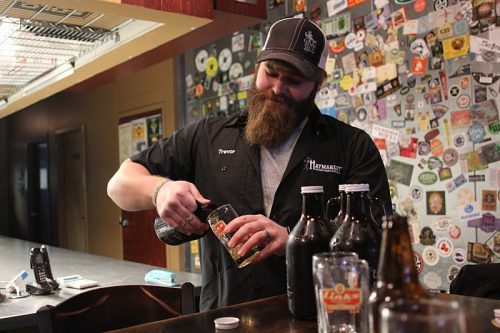
Haymarket brewer Trevor Hagen
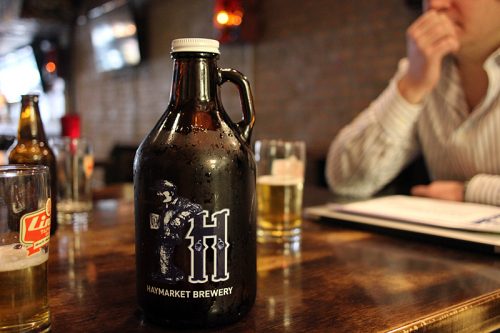
Spitting beer out in front of its maker isn’t rudeness—it’s par for the course when you’re tasting beer for your bar. Every Tuesday starting when Links opens at 11 am, Quinlan basically holds open auditions for beer makers, and this time he’s letting me hang out as he tastes and negotiates for the 36 taps on Links’ video display board of beers, which is a veritable tour of the craft beer industry in the Chicago region and around the country.
As Quinlan goes through the offerings from Haymarket, a couple of other representatives—they could be reps, they could be the brewers themselves—sit at the bar, waiting their chance. He introduces me to one sales rep for a self-distributed brewery, Tim Andrick of On Tour Brewing, whose ruddy red beard and satisfied beer-drinker’s shape make him look born to the part. Links has only carried On Tour for a short time—it’s only existed since January—and Quinlan tells me Andrick will be a good choice to give me an idea of what it’s like trying to get a new beer into bars—like his.
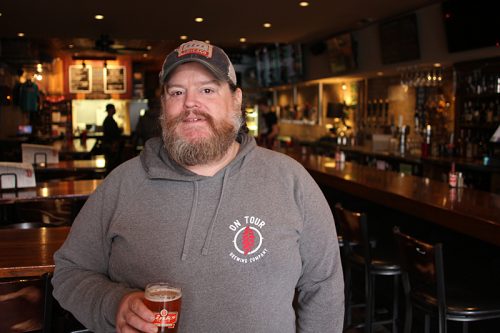
Tim Andrick, On Tour Brewing Co.
ON TOUR OPENED ITS BREWERY AND TASTING room right at the start of the year, in West Town. “It’s becoming a little bit of a brewery center—Goose Island is close to us, obviously, All Rise is right on Ashland there, behind us is Great Central, the contract brewer, they’re going to be opening a tap room soon, Forbidden Root’s right up on Chicago,” Andrick explains.
He says that in terms of getting their name and beer out, they’ve mostly been focused on the tasting room, but are trying to get their beer into some key locations where the customers are known for checking out what’s new. “We’re self-distributing guys, so we’re just out there trying to get our foot in the door in the right place, and make the right mark. I’m out there selling beer, and [founder Mark Legenza] is out there selling beer, and we’re splitting the city up a little bit.”
I ask Andrick how he got into distribution. “For years I was kind of on the other side, I was managing bars, and buying beer, so I know a lot of people in the industry already,” he says. “I knew a lot of the places that I wanted the brand to be in, and you focus on those places first. I like to sell beer to places where I like to drink beer, you know?”
First things first, I have to taste your beer. Just because your mom says you make good beer, doesn’t mean you make good beer.
He says “We don’t have that flagship brand yet,” a beer in a popular style whose breakout success helps define the brand, like Daisy Cutter pale ale has for Half Acre, or double IPAs have for Pipeworks. “We’re making new beers all the time. A lot of it comes down to finding the places that like to rotate beers through. Sheffield’s has been a great account for us, Lemmings down the street from here is another. And then we have a few places that kind of do a rotating handle, like Lucky Sandwich, they’re committed to their draft beer being really a local beer lineup. Smallbar, Map Room—I don’t know if Jay’s tapped it yet this week but I just delivered to him.”
I ask him how it went when he first approached Quinlan at Links. “It went pretty well,” he says. “I’d had about a year of being out in the market with another brewery that went through a distributor, so I’d had some success with Michael. We’re having more success now with an independent brewery.”
“We sat down and we talked, it’s a combination of coming to him with knowledge about the product, but also having a good product,” he says. “The exciting thing about being a new brewery with so many different things is that I was able to walk in on day one with five or six different beers right away, so something that represents all the different styles, everything from a stout to a Belgian-y kind of pale, to an IPA. Something for everybody’s palate, and also something to fill a gap in your lineup.”
On that first visit to Links, “I think we ended up going with a West Coast style IPA. It’s a nice, juicy, West Coast-y IPA, and in this area, Bucktown to Wicker to Logan Square, IPAs do very well.” That was in January, just a few weeks after the brewery started distributing. “Then we did a Belgian rye, which we had a keg of that, and then we did another IPA, not West Coast style but more Simcoe hop-focused, so a little more of that resin-y note to it.”
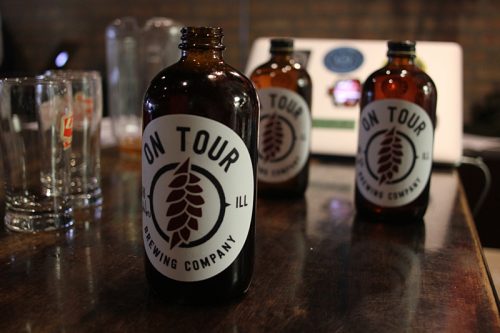
He seems confident about making a sale today, so I ask him if he’s ever bombed out anywhere. “Sure. Some places, we’re just not for them, or certain places, being a new brewery they’re just skeptical at first. ‘Oh, new brewery, ugh, I don’t have to time to deal with anybody else. I work with three or four distributors, and I just don’t have time to deal with another person.'”
To get people to try something new, “It has to be a place where they trust the customers and the customers trust them to make recommendations,” he says. “Some places just want to sit back and serve what’s easy. But what’s great is, there are definitely craft beer bars. And there’s good beer to be found in a lot of places these days. So there’s more opportunity today that didn’t exist maybe ten years ago.”
Still, there’s a lot of beer out there, and if they don’t want your beer, they don’t want your beer. “You just have to smile, walk away, and say, well, that’s just not the place for us. Maybe come back in six months, and we’ll see where we’re at.”
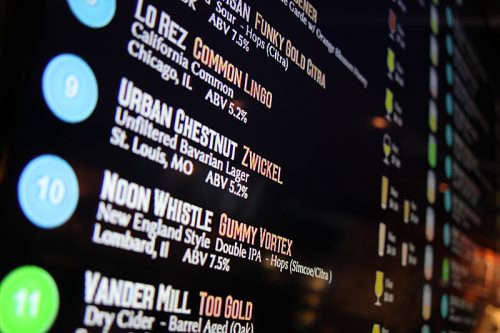
LINKS TAPROOM IS A LONG, NARROW bar, but its dominant feature is to be found duplicated on either wall—a series of video screens displaying what’s on the 36 taps at the end of the bar, with information about the brewery, style, ABV (alcohol by volume) and, geekiest of all, a display showing how much is left in the keg. (The kegs rest in a long narrow cooler, a spiders’ web of plastic tubing linking 36 kegs to 36 pipelines.)
Besides a convenience over updating paper menus for 36 taps, this display makes a statement of what kind of a bar Links is—one devoted to showcasing American craft beer, and always on the hunt for new breweries doing new, good work. Quinlan first saw the video display system—and just as importantly, the attitude he wanted his place to convey—on a trip a few years ago to the Pacific Northwest.
“I noticed that it was a lot less pretentious in the northwest than in Chicago,” he says. “You’d go into this place, and they’d have this incredible beer list. And us not being familiar with some of these breweries—people were happy to answer your questions, interact with you, talk with you. Where in 2011, at least, a lot of places in Chicago you would go into, if you asked too many questions you would kind of get that look, as if, you don’t belong, you don’t know what you’re doing.”
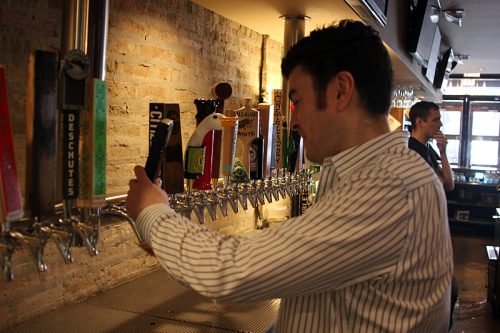
Links Taproom owner Michael Quinlan
“I wanted to capture that and bring it back to Chicago, because there wasn’t really a beer hall focused on craft beer then,” he says. “You step to the counter, you order your beer, you open your own tab, we’re happy to help if you order twelve beers at once.”
In Portland, he also found the display system at the first place to install it, Bailey’s Tap. Besides showing the beers (and the level in the keg), it also connects to assorted social media and beer-focused sites. “If you order a beer, and check into Untappd and say you’re at Links Taproom, it shows up on our menu screen. And who doesn’t like seeing their name in lights? And if we tap a beer, it immediately blasts out a message on social media, saying we tapped that beer. And it also tags the brewery, and nine times out of ten they’ll retweet that, and then everyone who follows that brewery will know we tapped that beer.”
“Our philosophy here is all American, all craft, local first, midwestern second, and American third,” Quinlan says. “We try to focus on the local guys—Half Acre, Revolution, Spiteful, Pipeworks, independent guys like On Tour… close your eyes and count to 20, and there’ll be three more breweries that just opened in Chicago. And even the bigger players like Goose Island—we weren’t on the Shun-Goose-Island-Because-of-AB/InBev [acquisition] thing. I understand why that was done, and as long as the beer doesn’t suffer, which so far it hasn’t, then I’m okay with it.”
Besides carrying so many local craft beers, Quinlan says it’s also key to Links’ atmosphere that the pricing structure is fair, as low as it can be, and resists exploiting hot beers of the moment. “Instead of beer flights, we do the half pour, which is actually nine and a quarter ounces, more than half,” he explains. “That gives people a chance to taste around the menu without having to buy a full pour.” I ask him why he seems to be against flights. “I’ve seen places where they do a flight and it never changes. Our roster changes too much for that. The only beer that never changes is Half Acre Daisy Cutter. And having said that, right now I don’t have it on the menu.”
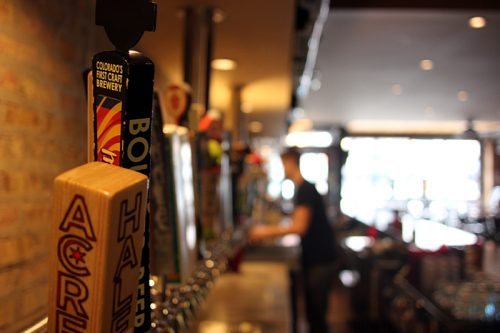
Treating the customers in a friendly and fair manner is important to him, and the same is true for breweries. “It’s all about relationships. You don’t want to be the account that never pours Goose Island, and then turns around and demands Bourbon County Stout when it comes out. I just don’t think that’s cool, I don’t think it’s the right thing to do. I think you have to support all of a brand, bread and butter stuff, not just the coolest part of the brand. They’re gonna go sell those beers to the places that support them.”
“But we do get cool, allocated stuff, and when the weather’s at its worst, sleet, blizzard, horrible Chicago weather, that’s when we go into the cooler and tap one of those. A lot of our customers live within walking distance, and it tweets it out, and it’s a surprise. That’s the reward for our everyday customers.”
Still, much as he likes to geek out on weird, cool things (he pours me a sample of a beer that supposedly tastes like a a pastrami sandwich—it does), it’s a business, and buying beers that he can actually sell is the heart of it. “Somebody new in the market, first things first, I have to taste your beer. Just because your mom says you make good beer, doesn’t mean you make good beer. I don’t mean that to be mean, but there are a lot of breweries that aren’t going to make it. That said, if somebody’s making good beer, and they can keep it consistent, I’ll put it on.”
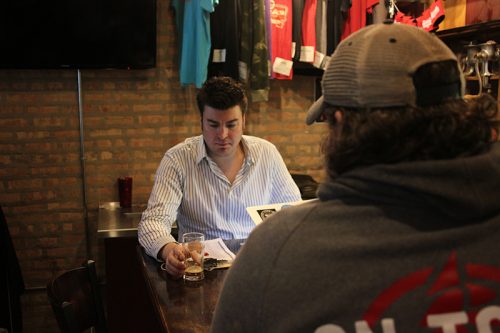
TIM ANDRICK IS UP NOW, POURING HIS first brew. “Last week we released another beer, another week another beer, and this is a red rye IPA, 6.7%, Cascade, Chinook and Amarillo hops going on here. 70 IBU,” he says, referring to a measure of hop bitterness. “Nice little balance of rye and malt and hops.”
Quinlan gives it a taste. “A lot of rye in there,” he says.
“Which I like. I’m a big rye guy,” Andrick says. “Especially, there’s a nice rye on the back end, it’s not overly dominating up front—”
But Quinlan seems to be beyond talking the rye already. “You guys get such good resin out of your beers, it’s amazing,” he says.
“Blows me away every time,” Andrick agrees.
“It’s the opposite of Haymarket, who was telling me they’re not using a lot of bittering hops, where you guys don’t shy away from it.” Quinlan gazes into the beer, judging its color, probably. “I like it both ways, but you need both ends of the spectrum.”
“I agree,” Andrick says.
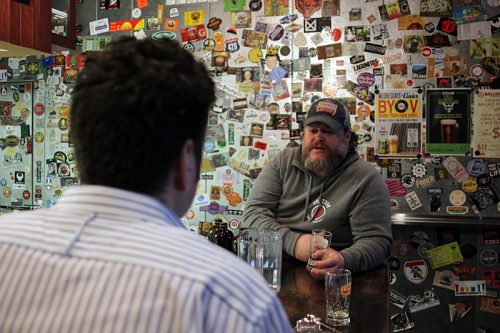
Andrick pours another. “I just wanted to revisit the Simple C To G, the double IPA, that I brought in last week,” he says. “Four pounds of hops on this one—”
Quinlan smacks his lips. “It is so intense,” he says. “It’s juicy, though.”
“I think the Galaxy [hops] gives it that kind of grassy note,” Andrick says.
“I like that,” Quinlan says. “We haven’t had this in yet, have we?”
“No,” Andrick replies. “And as I said, the rye, literally released on Thursday. The other thing I have is that Backroads Belgian Strong, if you’re looking for something Belgian-y.”
“Uhhhhh, I’ll taste it,” Quinlan says, with less than full enthusiasm.
“It’s a big one, 10%, like a banana creamsicle kinda flavor, for grownups,” Andrick says. He pours it quickly as he talks, as if he suspects a window might be closing.
Quinlan tastes it. His first reaction seems to maintain the skepticism: “Gotta lot of banana in it,” he says. He smacks his lips a couple of times, but something’s working on him. “It’s pretty fuckin’ good,” he says. “A lot of banana, but it’s not cloying.”
At that moment Quinlan spots someone walking in the bar with a can of beer. “YEEEEAHHH!” Quinlan shouts. “Thanks, dude. Did that one comes off the line yesterday?”
“Sure did,” the visitor says, plopping the can, Half Acre Vallejo, on the table in front of Quinlan, then turning around and taking his place at the bar.
“This is their warm summer IPA, it just came off the line,” he explains to me. He turns back to the banana-flavored Belgian. “That’s good, dude,” he says. “10%, huh?”
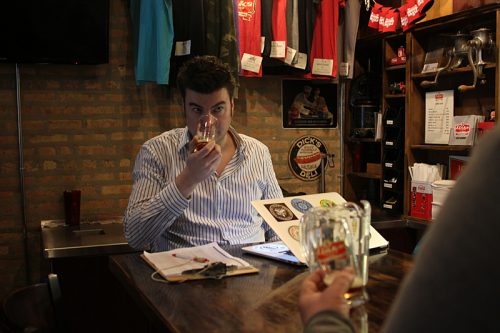
“10%. You get a little booziness on the back end, but the banana covers it up. It drinks too easy. But yeah, it’s a scary 10, but I just wanted to get it back out there, where you’re at, I’m not sure,” Andrick says, uncertain if he’s making a sale or not.
Quinlan looks over his spreadsheet. “Considering my order progression today, which has been a lot of IPAs…” he pauses… “Let’s get that Belgian going. Let’s do it.”
“I love it. I love having it out there,” Andrick says.
“It’s something different,” Quinlan says, visibly excited by this latest addition to his bar’s very eclectic list.
In the end, he takes both the Belgian and the double IPA. Quinlan has two new beers from a new name in Chicago—and On Tour has two of its beers in a bar where people find new beers to talk about.
Michael Gebert is rarely over 6% ABV as editor of Fooditor.
Latest
Join the Discussion
After you comment, click Post. If you're not already logged in you will be asked to log in or register with Disqus.





